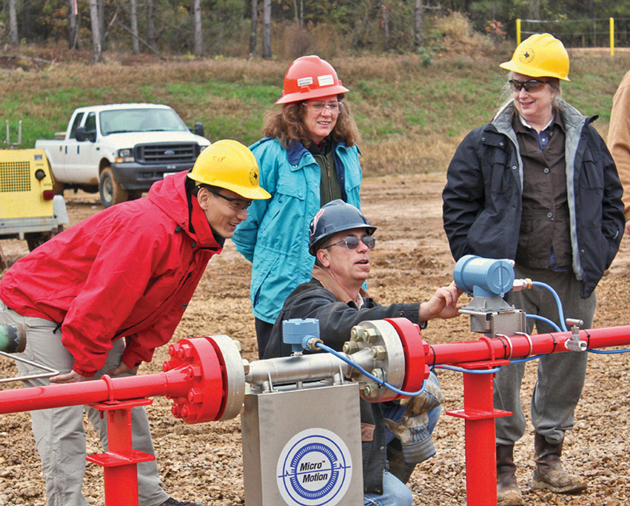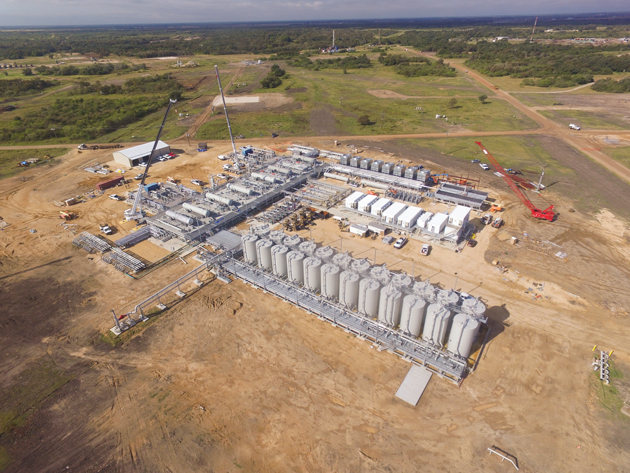本文转自《Texas TEXES》发表的题为“Inside a Plan at UT to Capture and Store Carbon—Forever”的报道。
作者:RYAN DUFFY
日期:2018.07.01
原文链接:http://alcalde.texasexes.org/2018/07/inside-a-plan-at-ut-to-capture-carbon-and-store-it-forever/

On a cold, sunny December day in Austin, a cadre of UT researchers trekked out to the Brackenridge Field Laboratory, an 82-acre biological research site on Lake Austin Boulevard. In these fields are a few dozen research wells ranging from one to 20 feet deep. The researchers injected liquid carbon dioxide from small pressurized bottles into the wells, and waited to see what would happen.
在奥斯汀12月的一个寒冷、阳光明媚的日子,一群UT研究人员跋涉到布拉肯里奇野外实验室,该实验室位于奥斯汀湖大道上,占地82英亩。在这些领域中,有数十个深度为1至20英尺的研究井。研究人员将液态二氧化碳从小型加压瓶注入井中,等待看到会发生什么。
This experiment was just one small part of a campus-wide, decades-long effort at UT to master carbon capture and storage (CCS). The idea is that companies and governments can capture CO2 before it exits the smokestack of an industrial facility, transport it away from the site, and pump it underground into an aquifer or geological formation that will hold it forever. If executed correctly, CCS would lessen the amount of carbon reaching the atmosphere and stave off climate change.
这个实验只是UT在大学范围内长达数十年的努力中掌握碳捕获和存储(CCS)的一小部分。这个想法是,企业和政府可以在二氧化碳排放到工业设施的烟囱之前将其捕获,将其从工地运输出去,然后将其泵入地下的含水层或地质构造中,永久保存它。如果正确执行,CCS将减少进入大气的碳量,避免气候变化。
It may sound ambitious, but it’s no pipe dream. The technology to do it is here, thanks in no small part to various teams of UT geologists, chemists, and petroleum engineers who have been working on CCS for two decades. CCS’s proponents eye it as an ailment to our carbon-addled society, allowing us to keep gas- and coal-fired plants online as we wean off our high levels of emissions, decarbonize, and stabilize the climate.
这可能听起来雄心勃勃,但这不是梦想。要做到这一点的技术在这里,这要归功于已经在CCS工作了二十年的各种UT地质学家,化学家和石油工程师团队。 CCS的支持者们认为它是我们碳化社会的疾病,使我们能够在我们废除高排放水平,脱碳和稳定气候的同时保持天然气和燃煤电厂的在线运行。
“Nearly anyone who has turned on a power source today has benefitted from [fossil fuels],” says Sue Hovorka, MA ’81, PhD ’90, a senior research scientist at UT’s Bureau of Economic Geology. Fossil fuels form the lion’s share of energy production. The world is still heavily invested in carbon-intensive industries. Hovorka says that could change. “Many people have become aware that fossil fuels, as well as being part of the solution, are part of the problem,” she says. In this light, CCS is seen as a pragmatic compromise: The benefits of petrochemicals can be retained while mitigating the costs.
“现在几乎任何一个已经开启电源的人都从化石燃料中受益,”马萨诸塞州州立大学经济地质局高级研究科学家,90年代的Sue Hovorka博士说。化石燃料形成了大部分能源生产。世界仍然大量投资于碳密集型产业。 Hovorka说这可能会改变。 “许多人已经意识到化石燃料以及解决方案的一部分都是问题的一部分,”她说。有鉴于此,CCS被视为一种务实的妥协:石化产品的优势可以保留,同时降低成本。
As a geologist, Hovorka’s expertise is on the storage side, also known as carbon sequestration. She studies how to make storage safe and effective. Hovorka and her team work with geological formations in Texas, and recently, the seafloor of the Texas Gulf Coast. The latter has a real advantage: It’s the edge of the continent, it’s shallow, the sediment can accept large volumes of CO2, and the area belongs to the state. “And the subsurface is a porous medium. It’s a bit like a sponge: What goes in doesn’t come out,” Hovorka says. Finding the right medium is a crucial step to ensure that after the CO2 is bottled up and pumped under, it stays there.
作为地质学家,Hovorka的专长是存储方面,也被称为碳封存。她研究如何使存储安全和有效。 Hovorka和她的团队研究德克萨斯州的地质构造以及德克萨斯州附近的墨西哥湾沿岸的海底。后者具有真正的优势:它是大陆的边缘,它很浅,沉积物可以接受大量的二氧化碳,并且该区域属于该州。 “地下是一种多孔介质。这有点像海绵:进来的东西出不来,“Hovorka说。找到合适的介质是确保在二氧化碳被装瓶并泵入之后的关键步骤,它将保持在那里。
Hovorka and her team’s work is complemented by that of Gary Rochelle, a UT chemical engineering professor. Rochelle’s expertise is in amine scrubbing, a technological method that separates the CO2 from the flue gas of coal- and gas-fired power plants. Amine scrubbing is the most effective CCS technology, Rochelle says. As one of the foremost experts on the technological capture side, Rochelle says that we have the requisite technical know-how to put CCS on power plants all across the world.
Hovorka和她的团队的工作得到了UT化学工程教授Gary Rochelle的补充。 Rochelle的专长是胺洗涤,这是一种将二氧化碳与燃煤和燃气发电厂的烟气分离的技术方法。 Rochelle说,胺洗涤是最有效的CCS技术。 作为技术捕获方面最重要的专家之一, Rochelle表示,我们拥有必要的技术知识,可以将CCS应用于全世界的发电厂。

But there’s a catch: the hefty price tag. Capturing carbon is expensive, to the tune of about $1 billion per plant, Rochelle estimates. Capture systems also reduce a plant’s energy output and efficiency. Widespread adoption is “not going to happen just because we keep working on the technology,” Rochelle says.
但有一个问题:价格昂贵。Rochelle估计,捕获碳是昂贵的,每个工厂捕集碳的成本约为10亿美元。捕获系统还可以降低工厂的能量输出和效率。Rochelle说,广泛的采用“不会因为我们继续致力于这项技术而发生”。
In the past, critics say, CCS has promised much and delivered little. Some projects have hemorrhaged money; others were scuttled due to cost overruns and production delays. Neither side of the political aisle is exceptionally thrilled with it. Given the substantial price tag, few in the industry have opted to go for it.
反对批评人士说,在过去,CCS承诺了很多并且交付的很少。一些项目出现了资金流失,其他人因成本超支和生产延误而被剔除。政治过道的任何一方都对此非常激动。鉴于价格大幅上涨,该行业中很少有人选择采用。
Regardless, there are some promising signs on the horizon for CCS. In April 2017, NRG Energy cut the ribbon on its Petra Nova project near Houston, the world’s largest post-combustion carbon capture system. UT’s involvement was instrumental, says David Greeson, BBA ’80, VP of development at NRG. UT petroleum engineering professor Larry Lake identified spent oil fields that could handle CO2 injections. Rochelle’s work “was invaluable to the whole industry and everybody that’s got an amine scrubbing carbon capture technology” has benefited, Greeson says. And Hovorka’s team is actively involved in an ongoing basis monitoring the CO2 storage.
无论如何,CCS有一些前景看好的迹象。 2017年4月,NRG Energy在世界上最大的燃烧后碳捕集系统在休斯顿附近的Petra Nova项目剪彩。 BBA'80开发副总裁David Greeson表示,UT的参与是有帮助的。特拉华州石油工程学教授 Larry Lake确定了可以处理二氧化碳注入的废油田。 Greeson表示,Rochelle的工作“对整个行业来说都是无价的,每个人都拥有胺清洗碳捕集技术”已经受益。 Hovorka的团队积极参与持续监测二氧化碳封存的工作。
The right incentives, like a U.S. Department of Energy grant, Texas tax credits, and a low-interest loan from the Japanese government, coupled with the geography, resources, and university’s assistance, made Petra Nova feasible, say Greeson and NRG Communications Director David Knox, BA, BS ’79. The company’s down-range goal is to “start our coal fleet down a path of decarbonizing,” Greeson says. But with the current prices of electricity, oil, and renewables, and lacking further incentives, it would be economically indefensible, he says, to build another Petra Nova.
Greeson和NRG Communications主任 David Knox说,正确的激励措施,如美国能源部拨款,德克萨斯州税收抵免以及日本政府的低息贷款,加上地理,资源和大学的协助,使Petra Nova变得可行。Greeson表示,该公司的下调目标是“让我们的煤炭车队走上脱碳之路。但是随着电力,石油和可再生能源的当前价格的上涨,以及缺乏进一步的激励措施,他说建立另一个佩特拉诺瓦在经济上是不可行的。
Though the technology at Petra Nova has yet to scale, there is ample interest in it, from the oilfields of Texas to the corridors of Washington, D.C. Corporate interests and nation-states alike are bankrolling research. Members of Hovorka’s team have hosted Mongolians in Midland and Norweigans on the Gulf Coast. NRG is in talks with other coal-fired plant owners about lessons it has learned from Petra Nova. A generous CCS tax credit was tucked into February’s continuing budget resolution and President Trump praised clean coal in his State of the Union address.
虽然Petra Nova的技术尚未扩展,但从德克萨斯州的油田到华盛顿特区的走廊,人们对此充满兴趣。企业利益和民族国家都在为研究提供资金。Hovorka团队的成员在米德兰和墨西哥湾沿岸接待了蒙古人和挪威人。 NRG正在与其他燃煤电厂业主就其从Petra Nova获悉的经验教训进行谈判。慷慨的CCS税收抵免被卷入2月份的持续预算决议中,特朗普总统在他的国情咨文演讲中称赞了洁净煤。
In the coming months, fieldwork will continue at Brackenridge. Geologists will scour the Texas landscape for new storage sites. Engineers will test how different solvents absorb carbon. Whether UT’s CCS work is mapped onto existing and new power plants is less clear. “It’s not inexpensive, but we can do it,” Rochelle says. “If we’re willing to recognize this as a problem and say that we need to do something about it, it can happen.”
在接下来的几个月中,布拉肯里奇将继续进行实地考察。 地质学家将在德克萨斯州的景观中寻找新的存储地点。 工程师将测试不同的溶剂如何吸收碳。 UT的CCS工作是否映射到现有的和新的发电厂还不太清楚。 “这不便宜,但我们可以做到,”Rochelle说。 “如果我们愿意认识到这是一个问题,并说我们需要做一些事情,那可能会发生。”